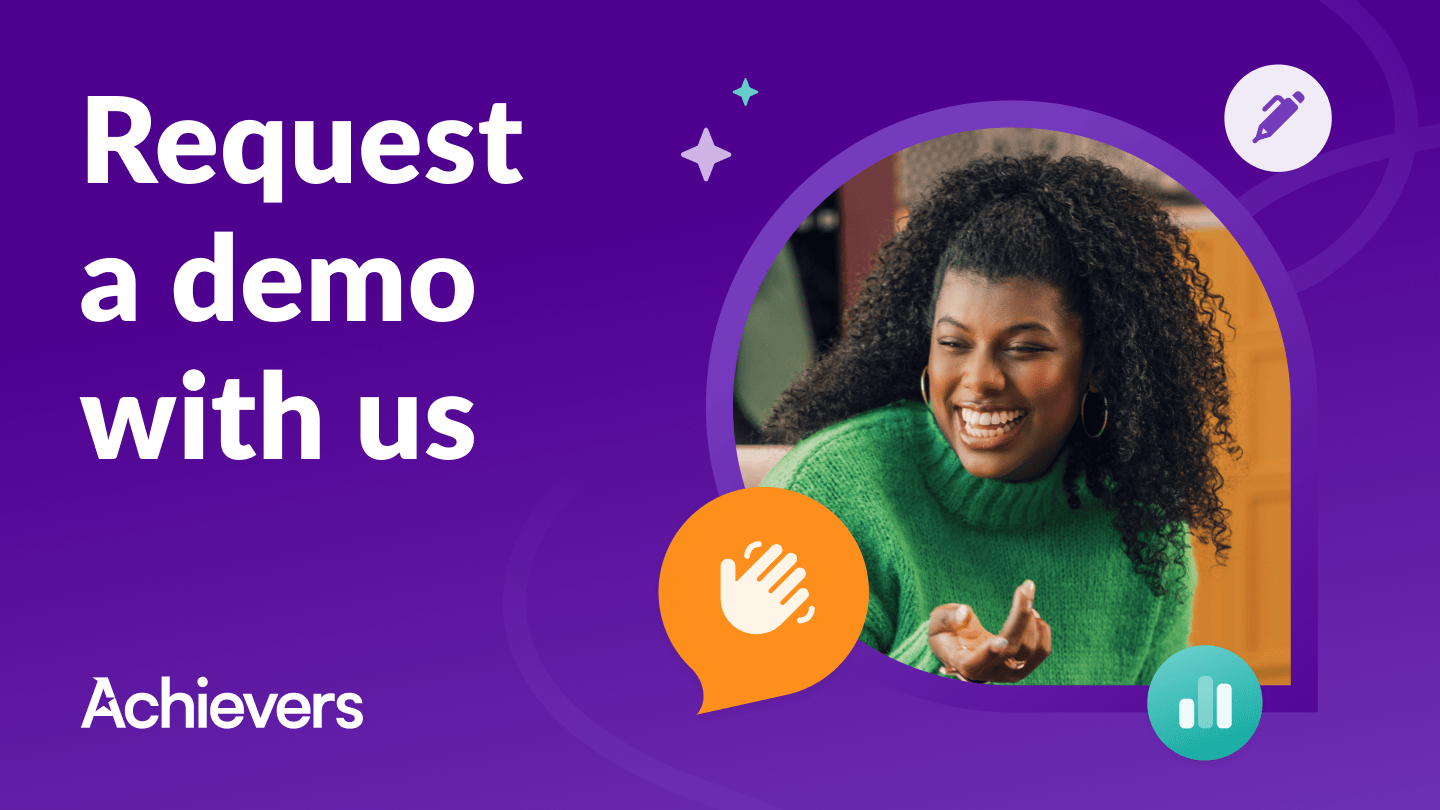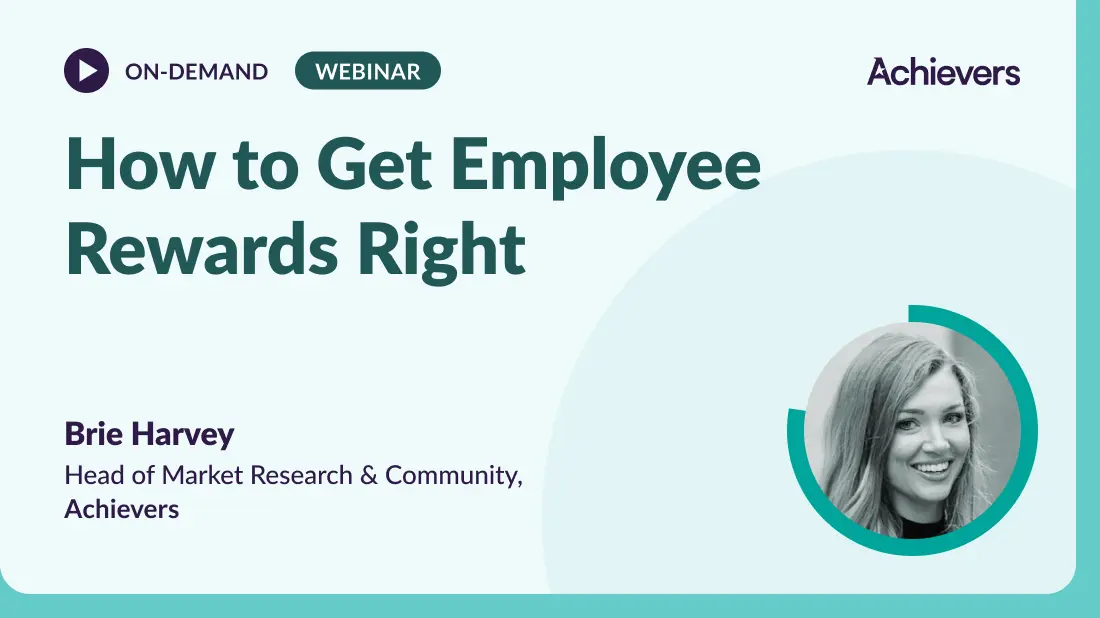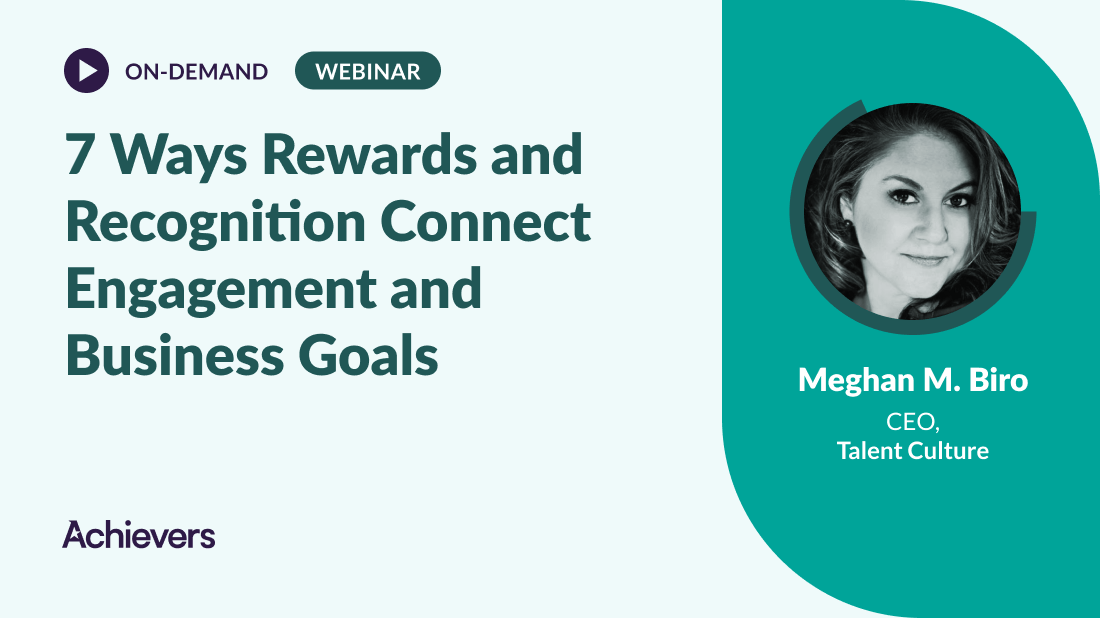Table of contents
Disengagement among employees is a growing concern, with a lack of incentives leading to high turnover rates, low productivity, and a negative impact on your bottom line. For example, did you know that unhappy workers cost the U.S. a staggering $1.9 billion per year? That’s why effective employee rewards programs are more important than ever.
Leaders and HR professionals have a significant role in sustaining employee engagement and motivation. To do this successfully, you need to understand the current state of recognition, its impact on your workforce, and how best to incentivize your teams.
What is the definition of incentives?
Incentives are things that motivate or encourage someone to take a specific action, or to avoid action. It refers to an external influence, like the expectation of a reward, which prompts an individual to take action. The role of an incentive is to drive desired behaviors and attitudes for a desired outcome.
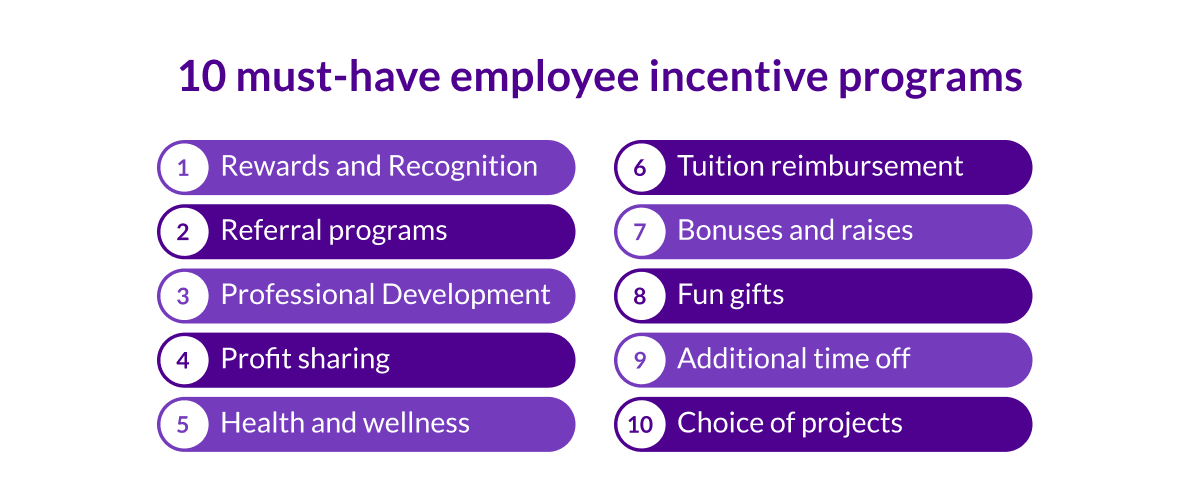
What are must-have employee incentive programs?
Employee incentives are vital to fostering motivation, boosting morale, and improving retention. Offering creative and meaningful programs ensures employees feel valued and engaged. Here are 10 must-have employee incentive programs that every organization should consider:
- Rewards and recognition
- Referral programs
- Professional development
- Profit sharing
- Health and wellness
- Tuition reimbursement
- Bonuses and raises
- Fun gifts
- Additional time off
- Choice of projects
By implementing these programs, organizations can create a more positive, engaging, and productive workplace while strengthening employee satisfaction and loyalty.
What is another word for incentive?
Another word for incentive is “motivator.” Both terms refer to something that drives or encourages individuals to achieve certain goals. Incentives often come in the form of rewards and benefits, which serve as motivators by providing tangible recognition and perks. Rewards can include bonuses or gifts, while benefits might encompass additional time off or health insurance. These motivators play a crucial role in boosting performance and engagement by recognizing and valuing employees’ contributions, ultimately driving desired behaviors and outcomes.
What are the most common examples of incentives?
Employees are incentivized by different things. However, the most common employee incentives include:
- Monetary bonuses
- Salary raises
- Additional vacation days
- Public recognition
- Health and wellness reimbursements
- Referral bonuses
- Professional development opportunities
- Tuition reimbursement
- Shared team-building experiences
- VIP experiences
- Company swag
- The option to select a personalized reward
The value of employee incentive programs
To boost employee morale and drive engagement, you need effective employee incentive programs. Recognizing their importance, U.S. businesses collectively spend $176 billion on incentives, recognition, rewards, incentive travel, and corporate gifting.
Incentive programs are effective because they leverage human behavior. Immediate rewards increase intrinsic motivation by linking an activity with a goal, making employees more motivated to complete associated tasks when rewarded frequently. Organizations that use employee incentive programs often see a higher success rate in achieving their goals.
Moving beyond annual years of service awards to embed employee incentive programs into your everyday culture can significantly boost performance and motivation. These programs can increase employee performance and encourage employees to remain with their company. Additionally, companies using tangible sales incentives often see substantial revenue growth, and professionals satisfied with their benefits are more likely to be satisfied with their work.
25 employee incentive programs to improve engagement
Employee incentive programs have tremendous benefits, but where should you start? Here are some incentive examples that have been proven to engage and motivate employees over the long haul.
1. Social recognition programs
Social recognition is a powerful tool for boosting engagement by fulfilling the human need for acknowledgment and validation. Recognizing employees publicly enhances their self-esteem and reinforces positive behavior, creating a culture of appreciation. This leads to higher motivation and productivity, as workers who receive social recognition are 3.7 times more likely to be engaged and 55% less likely to seek a new job.
Additionally, social recognition fosters a supportive work environment. When employees see their peers recognized, it sets a positive example and motivates everyone to excel. Integrating social recognition helps build a culture of continuous improvement and mutual respect, enhancing overall job satisfaction and engagement.
2. Points-based recognition programs
Points-based recognition provides a tangible and flexible way to reward employees by allowing them to earn and redeem points for various rewards tailored to their preferences. To maximize effectiveness, these systems should connect to a comprehensive reward marketplace, offering a wide selection of merchandise, gift cards, travel experiences, charity donations, and concierge services. Employees with access to reward marketplaces are 61% more likely to feel a strong sense of belonging and 60% more likely to feel meaningfully recognized at work.
Points-based systems also foster a culture of ongoing recognition by consistently acknowledging contributions. This creates a positive feedback loop that motivates high performance, maintains engagement, and promotes a sense of accomplishment. Regular reinforcement through points drives sustained productivity and commitment.
3. Referral programs
Referral programs incentivize employees to bring in new talent, often offering rewards for successful candidate referrals. For example, positions filled through employee referrals retain employees 46% longer than other methods — a statistic HR professionals love. Regularly reminding your workforce about your referral program ensures a steady stream of candidates and allows employees to earn monetary incentives for recommending qualified individuals who fit your culture.
To make it beneficial for employees, you can implement a tiered rewards system within your existing recognition program. For example, employees could earn 1,000 points ($10) for submitting a referral, with rewards increasing to 2,500 points ($25) if the referral advances to the interview stage, and 10,000 points ($100) if the referral is hired. This approach integrates seamlessly into your recognition and rewards program, enhancing its effectiveness.
4. Professional development programs
Professional development involves coaching employees to achieve both individual and company goals. A global survey found that companies offering training to engaged employees are 17% more productive and 21% more profitable. Yet only 15% of full-time workers report being “highly involved in and enthusiastic about their work.” Investing in employees’ careers not only boosts their commitment but also benefits your company through the new skills and knowledge they bring, creating more opportunities for internal promotion.
To engage employees in professional development, consider developing your own learning and development (L&D) program or utilizing a third-party learning management system. You could also offer one-on-one mentoring with executives at the end of the program or gamify your existing L&D courses to make them more engaging.
5. Profit sharing programs
Profit sharing provides employees with a portion of the company’s profits, either through contributions to their retirement accounts or direct payments. It serves as an alternative or supplement to traditional retirement plans like a 401(k). Employers can adjust contributions based on earnings, offering flexibility to manage expenses.
Beyond financial incentives, profit sharing helps employees feel like owners, boosting loyalty and motivating them to contribute to the company’s growth. If profit sharing isn’t feasible, offering to match a portion of 401(k) contributions is another way to incentivize employees, typically limited to a percentage of their income.
6. Health and wellness programs
Health and wellness programs incentivize employees to adopt healthier lifestyles and fitness choices, which is crucial for preventing burnout and promoting overall well-being. With 80% of employees reporting burnout and 66% struggling with work-life balance, it’s essential for companies to support physical and mental health to ensure peak performance.
Practical wellness incentives include offering free healthy lunches, on-site health screenings, bike-to-work reimbursements, standing desks, and annual wellness fairs. Additionally, rewarding employees for achieving wellness milestones, such as quitting smoking or completing a steps challenge, can be highly effective. A centralized rewards marketplace that promotes healthy habits both at work and home can further enhance employee wellness initiatives.
7. Tuition reimbursement programs
Tuition reimbursement programs help cover the costs of employees’ education, either partially or fully. With ongoing education increasingly valued by employees, 82% report that skills or degrees gained through their employer’s tuition reimbursement program have made them more effective in their roles, while 84% feel it has prepared them for future work challenges. Additionally, 76% of employees are more likely to remain with their employer because of this benefit.
Encouraging continuous learning at all levels, including the CEO, can be reinforced through tuition reimbursement. Recognizing educational achievements, such as new certifications or advanced degrees, with team-signed digital cards and public acknowledgments helps build a culture of recognition and supports ongoing employee development.
8. Bonuses and raises
Bonuses and raises are additional monies paid to employees for attainment of specific goals or metrics. Rewarding employees with bonuses and raises can be incredibly powerful. For example, a recent survey by Robert Half International Inc shows that 52% of workers say receiving an annual bonus makes them feel more appreciated at work.
That said, you need to lay out crystal clear metrics and objectives so that employees know exactly how they can achieve their bonus. Strike a balance with your policies 一 the requirements shouldn’t be too difficult or too easy to meet. Be careful not to pit employees against each other, either. This can backfire and lead to resentment or even alienation from your company.
9. Fun gifts
Fun gifts are personalized or unique employee rewards given to employees showing appreciation for their work or to celebrate achievements. Celebrating your employees through gift-giving shows that you care. Gifts are great incentives for company-specific holidays, like work anniversaries, customer service week, global wellness day, or boss’s day. Try gamifying each of these holidays with fun contests and quizzes, and reward and recognize employees who participate the most.
Popular employee gifts run the gamut, from onsite massages, to catered lunches, to a half-day off work. Tech gadgets, delicious snacks (delivered or in-office), and quality swag (branded or unbranded) are great ideas as well. And for employees who would rather choose a gift themselves, providing gift cards is a great solution.
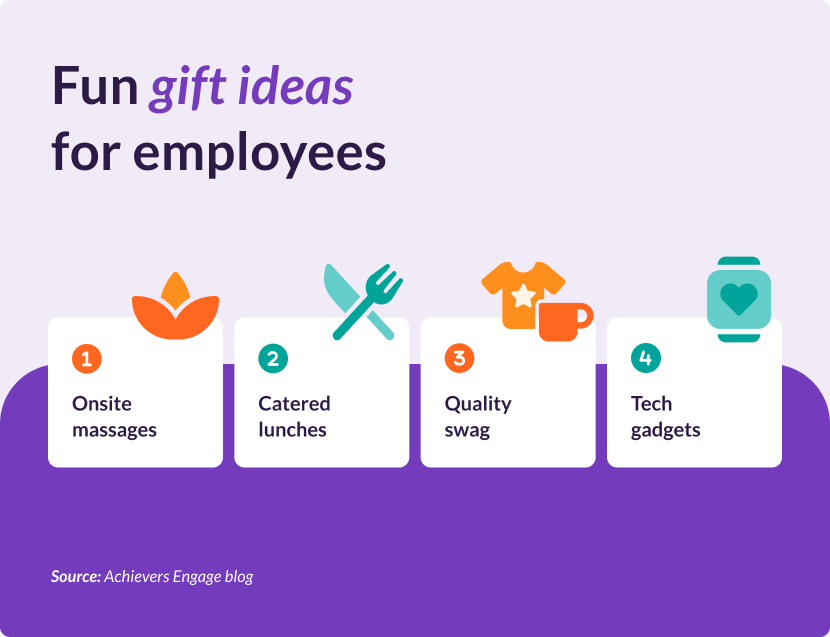
10. Additional time off
Additional time off is an incentive that provides employees with extra paid vacation time beyond their standard leave. This additional time off allows employees to better maintain their work-life balance, which can significantly boost motivation and productivity. It’s important to encourage employees to use their allotted paid leave, as 46% of workers take less time off than they are offered. By offering extra vacation time and flexibility when employees meet specific goals, companies can further enhance engagement and address rising issues of burnout and disconnection.
The value of flexibility extends beyond just paid time off. Many employees would consider accepting a lower-paying job if it meant having more flexible working arrangements. This highlights the growing importance of work-life balance and the potential of flexible work options to attract and retain talent.
11. Choice of projects
Choice of projects is the ability for employees to choose what they want to work on based on their interests or areas of expertise. Giving high-achieving employees the right to choose their own projects is a wonderful way to empower and incentivize them. Managers build trust when they permit employees to decide what to work on, something that many companies struggle with.
Of course, the project options you offer should be personalized and appealing to each employee. A blanket, one-size-fits-all incentive isn’t as impactful. Team leaders and staff should communicate with their employees about their short and long-term goals and career interests and offer projects to match.
12. Employee benefits program
Employee benefits encompass a range of tangible and intangible rewards provided to employees beyond their base salary or hourly wage. These benefits can include various forms of insurance coverage, such as medical, dental, and life insurance, which help protect employees and their families from unexpected expenses.
According to Gallup, pay and benefits — or lack thereof — is the most common reason employees left their job in 2023. Offering a comprehensive benefits package not only helps attract and retain top talent but also enhances overall job satisfaction. By providing a range of benefits that address different aspects of employees’ lives, companies can support their well-being, foster loyalty, and create a more engaged and productive workforce. These benefits demonstrate a commitment to employees’ long-term success and satisfaction, contributing to a positive organizational culture.
13. Human resources development
Human resource development (HRD) encompasses the strategies and practices aimed at enhancing employees’ personal and professional skills, knowledge, and abilities. By investing in HRD, organizations not only improve individual competencies but also boost overall organizational effectiveness. While training typically focuses on creating immediate improvements in job performance and addressing specific skills gaps, HRD takes a more strategic approach to foster long-term growth and alignment with organizational goals.
HRD contributes significantly to employee engagement by demonstrating a commitment to employees’ continuous development. When employees see that their organization is invested in their personal and professional growth, they are more likely to feel valued and motivated. This commitment can lead to higher job satisfaction, increased loyalty, and a greater sense of purpose.
14. Performance management programs
Performance management involves continuous communication and coaching between managers and employees to align individual goals with organizational objectives. This process includes clarifying job responsibilities, setting priorities, defining performance expectations, and creating development plans. Despite its importance, only 2 in 10 employees feel their performance is managed in a way that motivates them to excel, and just 14% strongly agree that their performance reviews inspire them to improve.
Effective performance management can significantly enhance employee engagement by providing clarity on how individual roles contribute to broader strategic goals. Regular feedback and recognition help employees understand their value to the organization and foster a sense of purpose. When performance management is executed well, it supports personal and professional growth, leading to increased job satisfaction and loyalty. By addressing these gaps and ensuring performance management practices motivate and inspire employees, organizations can boost engagement, improve productivity, and achieve greater overall success.
15. Travel incentives
Travel incentives are a compelling way to boost employee engagement by offering rewarding experiences for achieving specific goals. These incentives typically involve fully paid trips for individuals or teams who meet predetermined targets within a set timeframe. By providing such rewards, organizations can shape employee behaviors, drive engagement, and improve performance.
The effectiveness of travel incentives is underscored by their high value among senior leaders. According to the Incentive Research Federation, 53% of senior leaders view incentive travel as a “need to have,” while 48% consider it an “essential strategic differentiator.” Only 13% see it as an “area to cut.” This strong endorsement highlights the significant impact travel incentives can have on motivation and engagement. Offering these memorable rewards not only recognizes employee achievements but also fosters a sense of value and appreciation, creating a powerful motivator for continued high performance and commitment.
16. Commission programs
Commission is additional compensation earned by an employee based on their job performance, commonly used within sales teams. Employees in commission-based roles agree to be paid a certain amount that depends entirely on hitting specified goals or metrics. This structure creates a direct correlation between effort and reward, driving employees to perform at their best to achieve higher earnings.
The value of commission as an incentive is clear, especially given the massive investment U.S. organizations make in their sales forces — over $800 billion, with $200 billion devoted to compensation alone. Commission-based compensation directly links effort to reward, aligning individual goals with organizational objectives. This approach boosts engagement by making employees feel accountable for their success, enhancing productivity and profitability. By rewarding high performers with substantial earnings, companies can foster a competitive, motivated, and highly engaged workforce, ensuring teams always strive for excellence and deliver top results.
17. Flextime programs
Flextime, or flexible working hours, allows employees to adjust their workday based on personal needs or preferences. This could mean starting and finishing work at different times to accommodate childcare, aligning with colleagues in different time zones, or working during their most productive hours. Such flexibility supports a better work-life balance, reducing stress and increasing job satisfaction.
The appeal of flexible working hours is reflected in a telling statistic: 80% of employees said they’d be more loyal to their employer if provided with flexible working arrangements. By offering flextime, employers can boost employee engagement and retention. When employees have control over their schedules, they feel more trusted and valued, which enhances their commitment and productivity. Additionally, flexible hours can reduce burnout, as employees can better manage their personal and professional responsibilities. Overall, incorporating flexible working hours into company policies can significantly improve employee morale, loyalty, and overall engagement.
18. Employee resource groups (ERGs)
Did you know that employees who participate in relevant employee resource groups are 34% more likely to demonstrate high job commitment? According to the 2024 Engagement and Retention Report from AWI, this is because ERGs create a sense of belonging and community, which significantly enhances employee satisfaction and loyalty.
ERGs help break down silos and build stronger relationships across departments, contributing to overall efficiency and collaboration. This improved connectivity leads to higher levels of trust and advocacy within the organization. For instance, AWI also reports that employees who feel supported in building relationships are over 20% less likely to job hunt, and when ERGs are combined with other connection tools, employees are more likely to recommend their company to potential candidates, showing that ERGs not only improve engagement but also bolster long-term retention and organizational success.
19. Customized learning stipends
Customized learning stipends empower employees by funding their professional growth through courses, certifications, or conferences that align with their personal goals and career aspirations. This type of incentive demonstrates your organization’s commitment to continuous learning, which can increase loyalty and motivation among employees. By offering this perk, companies encourage individuals to upskill in areas that benefit both the employee and the business, fostering a culture of innovation and expertise.
The flexibility of allowing employees to choose their learning paths ensures that the program feels personal and meaningful. Whether it’s mastering a new software, earning a certification, or attending an industry-leading event, learning stipends help employees remain competitive in their fields. This incentive not only boosts employee satisfaction but also enhances your workforce’s capabilities, ultimately driving business success. Investing in your employees’ growth is a clear signal that you value their development and future within the company.
20. Sabbatical leave rewards
Sabbatical leave rewards offer employees the chance to take extended paid time off, typically after reaching milestones like five or ten years of service. This program highlights your organization’s appreciation for long-term dedication while providing employees with the opportunity to recharge and explore personal goals. Sabbaticals can be transformative, allowing employees to return with renewed energy, fresh perspectives, and enhanced creativity.
Whether they use the time to travel, learn a new skill, or simply relax, sabbatical leave supports their well-being and prevents burnout. Offering such a reward not only demonstrates that your company values work-life balance but also builds a culture of loyalty and trust. Employees who feel cared for are more likely to remain committed, reducing turnover and fostering a positive reputation for your brand. Sabbatical leave rewards can set your company apart as an employer of choice in a competitive job market.
21. Green commuting incentives
Green commuting incentives encourage employees to adopt eco-friendly transportation habits by offering tangible rewards such as gift cards, paid time off, or discounts on wellness programs. This program appeals to environmentally conscious employees and aligns your company with sustainability goals, showcasing corporate responsibility. Incentivizing biking, carpooling, or using public transit reduces employees’ commuting costs, improves their health, and lowers your organization’s carbon footprint. By implementing this program, companies foster a sense of community and shared purpose among employees striving for sustainability.
Additionally, offering perks for green commuting can enhance recruitment and retention, particularly for millennials and Gen Z workers who prioritize eco-conscious employers. These initiatives also contribute to a healthier work-life balance by reducing the stress associated with driving solo in traffic. Green commuting incentives demonstrate that your company is forward-thinking and willing to support both personal and environmental well-being.
22. Wellness challenges with rewards
Wellness challenges create a fun and engaging way to promote healthy habits among employees, driving both individual and team well-being. By organizing challenges — such as step-count competitions, mindfulness streaks, or nutrition goals — your company encourages camaraderie and a sense of achievement. To make participation even more motivating, offer rewards like gym memberships, wellness gadgets, or mindfulness app subscriptions to those who meet their targets.
These challenges show your organization’s commitment to employees’ physical and mental health, helping to reduce stress, improve focus, and enhance overall productivity. They also create a culture of wellness, which can lower healthcare costs and absenteeism over time. Employees feel valued and supported when they see their employer investing in their well-being. By making wellness fun and rewarding, you foster a healthy workplace environment that prioritizes health and builds stronger connections among teams.
23. Family-oriented perks
Family-oriented perks recognize the importance of employees’ personal lives by extending support to their families. These incentives can include scholarships for employees’ children, allowances for family outings, or festive holiday gift packages. By offering programs that benefit not just the employee but their loved ones, companies foster a deep sense of loyalty and gratitude. Employees with family support programs often feel more balanced and less stressed, allowing them to focus and perform better at work.
These initiatives also position your organization as a compassionate and inclusive employer, which can enhance retention and attract top talent. Family-oriented perks demonstrate that your company cares about employees as whole individuals, not just as professionals. This kind of recognition is especially impactful during key moments in an employee’s life, building stronger emotional ties to the organization and its mission.
24. Recognition through peer awards
Peer-nominated awards programs empower employees to recognize each other’s contributions, fostering a culture of collaboration and appreciation. By encouraging peer-to-peer recognition, you strengthen workplace relationships and increase morale. Employees feel valued when their efforts are acknowledged by colleagues who directly witness their contributions. Winners of these awards can receive meaningful incentives such as exclusive experiences, personalized gifts, or public recognition at company events. This approach democratizes recognition and allows employees at all levels to highlight impactful work, breaking down hierarchical barriers.
Peer awards also promote transparency and inclusivity, ensuring that achievements across the organization are celebrated. Such programs create a ripple effect of positivity, as employees are motivated to go above and beyond, knowing their efforts won’t go unnoticed. Implementing peer awards strengthens workplace culture and builds an environment of mutual respect and encouragement.
25. Innovation incentives
Innovation incentives reward employees for developing creative ideas that improve business operations, products, or services. By creating a program where employees can submit and pitch their ideas, you foster a sense of ownership and entrepreneurial spirit within your workforce. Recognizing and implementing these ideas through bonuses, leadership opportunities, or public acknowledgment reinforces the value of innovation. Employees feel empowered to think outside the box, knowing their contributions could make a tangible impact. This not only drives engagement but also fuels continuous improvement within your organization.
Innovation incentives encourage problem-solving and adaptability, which are critical in today’s fast-paced business environment. By celebrating creativity, you build a culture that prioritizes forward-thinking and rewards initiative. These programs show employees that their voices matter and that your organization is committed to leveraging internal talent for long-term success.
5 best practices for employee incentive programs
After you choose the right employee incentive programs for your company, you need to put them into practice. Here are some best practices that can help you implement impactful incentive programs:
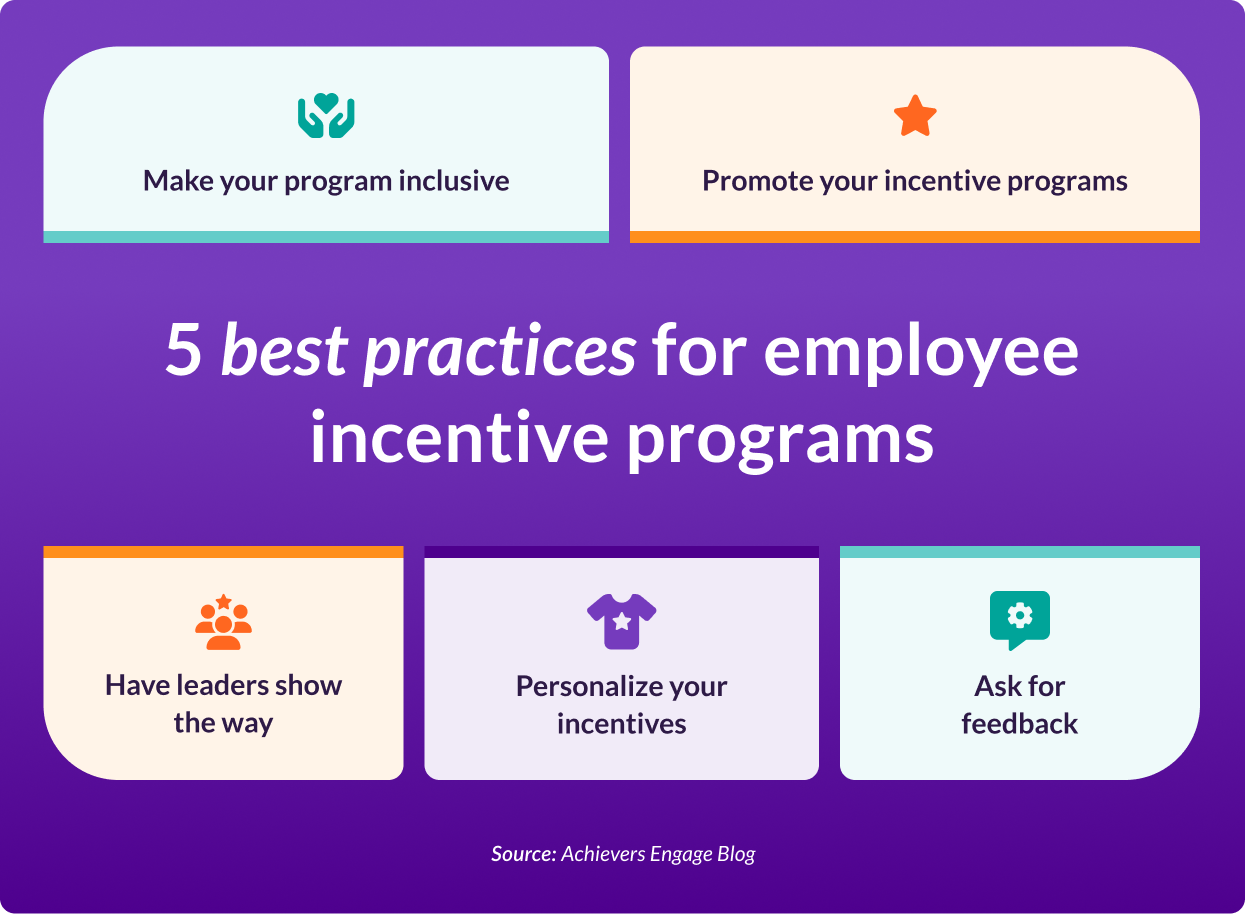
1. Make your program inclusive
Ensure all team members have access to your incentive programs by implementing a variety of programs that fit every area of your business. You should also recognize every stakeholder who helps lead your incentive programs, as well as all those who participate in them. And make sure your incentive program comes with an engaging, user-friendly platform where team members can easily participate and reap the benefits. All these practices can help employees feel involved and part of an inclusive work environment.
2. Promote your incentive programs
Ensure that everyone knows about your incentive programs to raise awareness and encourage company-wide participation. To accomplish this, HR should build a promotion and communications plan to make every employee aware of the available incentive programs. They can follow this up by working with leaders to run ongoing campaigns that engage employees and keep them participating. These campaigns might include marketing tactics like posters, fun messages using the company email or intranet, or games that tie into the incentives. Also, provide information about your incentive programs in your employee onboarding checklist so that every new hire is educated on day one.
3. Have leaders show the way
Leaders must serve as examples by actively participating in and advocating for incentive programs. After all, the success of employee incentive programs relies on leaders promoting and building awareness of incentives programs within their teams. Your HR team should train leaders on how your employee incentive programs work and on the value of using them as engagement tools. This could take the form of reference materials, training sessions or webinars, and even online learning courses. They can then effectively encourage their team members to adopt your company’s incentive programs.
4. Personalize your incentives
Personalizing your employees’ incentives experience is a must. Team members won’t work hard towards a goal if they aren’t compensated for it in a way that’s meaningful to them. Leverage technology like AI and advanced analytics to start tailoring each employee’s experience. Some HR leaders are using HR hackathons, employee-journey mapping, and design thinking to uncover employee needs. And of course, seeking feedback from employees is the best way to personalize their incentives.
5. Ask for feedback
Listening to your employees is essential for gathering accurate feedback on your incentive programs. Take the time to understand how well your current incentives are being received and what your employees truly want. Use an employee feedback platform to conduct pulse surveys and gain invaluable insights, as employees can provide ideas you might not have considered. An always-on feedback channel can also be beneficial, allowing employees to share their input anytime, anywhere. Customize your incentive programs based on this feedback to demonstrate that you value and consider their opinions and continuously check in with employee engagement surveys to ensure your adjustments are effective. Additionally, leaders should set up meetings with their teams to review survey findings and build collaborative action plans together. This approach not only improves your incentive programs but also fosters a culture of open communication and continuous improvement.
Make your incentives meaningful
Effective employee incentive programs play a key role in boosting engagement, motivation, and retention. When you offer meaningful rewards — like opportunities for professional growth, wellness programs, or recognition initiatives — you show employees they are valued. This creates an environment where employees feel inspired to contribute their best work every day.
Achievers Recognize™ and Achievers Rewards™ make implementing these programs effortless. With tools that streamline recognition, deliver impactful and personalized rewards, and track engagement in real time, Achievers helps organizations create a culture of appreciation that fosters loyalty and drives performance.
When employees feel seen and rewarded for their efforts, they thrive — and so does your organization. Start transforming your workplace with Achievers and discover how recognition can inspire your team to reach new heights.
